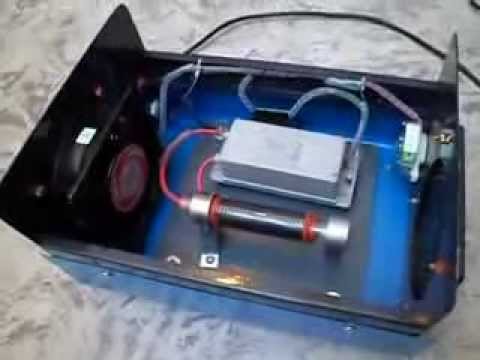Internal look at a typical ebay Chinese ozone generator. Not much inside, just a transformer, simple corona tube and a fan to blow the air through. It does produce a good output of ozone though.
I got this at a modest price on ebay as the listing hinted at it being faulty. The high voltage connection to the outer stainless steel wire had a poor connection that had arced and burned off. Easy to fix and restored the unit to full operation again.
The corona tube is just a glass tube with a piece of thin stainless steel mesh rolled up and allowed to unfurl against the inside of the tube making a large area plate along it’s internal surface. A stainless steel wire is coiled around the outside and when a high voltage high frequency supply is applied a corona discharge occurs around the outer wire as current transfers back and forth between the inner plate and outer wire capacitively. Air is blown along the tube and where oxygen (O2) passes through the corona discharge the oxygen atoms are separated and some combine as stable O2 and unstable O3 (ozone) which tries to get rid of it’s extra atom of oxygen onto anything it can attach to. This is why ozone is such a strong oxidiser and why it smells like bleach (it’s oxidising your nose!)
Ozone can be used to get rid of strong smells and kill airborne bacteria. However, it can cause corrosion of rubber and metals in long term exposure. You should also avoid breathing in excess amounts. A typical rule of thumb is that if you can smell it then there’s too much to stay in the room. Prolonged exposure will cause throat, nose and eye irritation.
The bigger units like this one are fitted with timers so they can be left unattended in rooms and after the unit has turned off the bulk of the ozone will have dissipated in typically 20 to 30 minutes.
Share
Inside a Chinese ozone generator.04:33
Published on February 2, 2018

